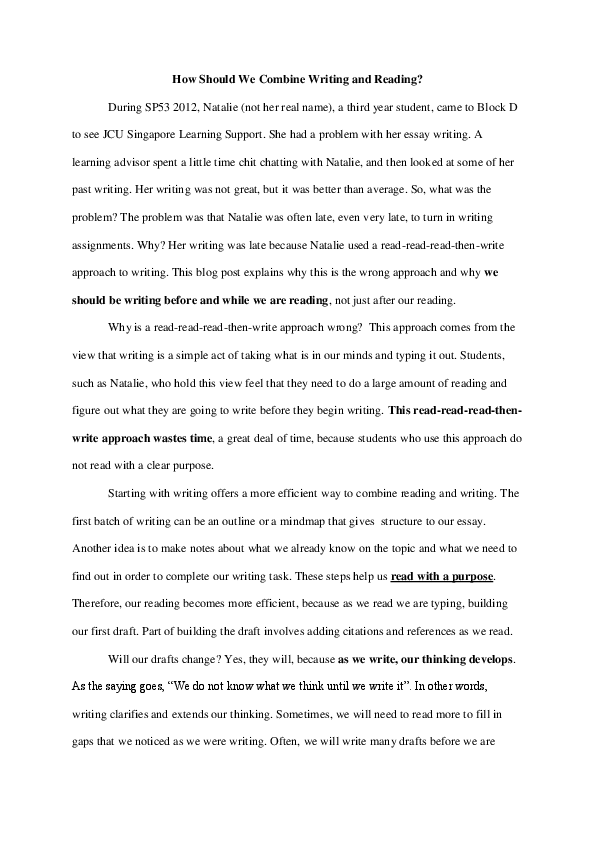Academia.edu no longer supports Internet Explorer.
To browse Academia.edu and the wider internet faster and more securely, please take a few seconds to upgrade your browser.
How Should We Combine Writing and Reading?
How Should We Combine Writing and Reading?
2013, James Cook University Singapore website's blog page
Why we should write before and while reading, not only after reading.
Related Papers
2016 •
It is of utmost importance to shed lights on the issues related to ‘writing’. There are in fact many reasons for such an interest on the part of both the teacher and the student. Writing represents, first, one of the major criteria of assessment of any student who is supposed to interact with subjects, topics, problems, theses, hypotheses, analyses and discussions while s/he ‘writes’. Writing for a student is, therefore, a necessary daily activity that reflects his/her ideas and understandings for the issues the curriculum proposes or for any other issue. Writing, secondly, is a hindrance for many students who find certain difficulties in conveying the appropriate meaning using the appropriate linguistic structures. This paper will present the effects of reading on writing and try to provide a clear and plain definition of creative writing in a way that will help students or writers in general to overcome the problems they may have in writing or to improve their linguistic production.
2000 •
A brief retrospective is first provided on the study of reading and writing relations. Next, it is suggested that research has supported the theoretical contention that reading and writing rely on analogous mental processes and isomorphic knowledge. Four basic types of shared knowledge are delineated. Then, reasons are articulated about why it is also important to consider the separability of reading and writing. Further, over time, as reading and writing are learned, the nature of their relation changes.
This article offers an overview of the relationship between writer and reader, as understood from the ancient world to the present day. It traces this relationship through Greek philosophy, Elizabethan poetics, eighteenth-century criticism, and so to Romanticism and its legacy. It then addresses the twentieth-century attempt to put the writer and reader in their place, before commending the contribution of one particular thinker—a Christian philosopher—to the debate.
2020 •
W cleaned and wrangled the data, we’ve made picture-perfect plots, and we’ve performed our statistical analysis. Now it’s time to share our findings with the world. This is a step that novices and experts alike balk at. That blank screen of our future manuscript is intimidating. Instead of staring at a blank screen waiting for inspiration to hit, we can take action. In fact, even now, as you read this magazine, you can get ready to write. Learning how to write can start with reading data-related articles and examining how the author organises and writes about their findings. When we “read to write”, we identify the main components of a data analysis and notice how the author brings these components together to form a logical and compelling story. During this deliberate process, we discover examples and templates that we can use to organise our own work and write about our findings. It can be daunting to develop an “ear” for writing. However, reading to write is a skill that can be h...
1984 •
RELATED PAPERS
The Lower Volga Archaeological Bulletin / Нижневолжский археологический вестник
Дружинина И. А. и др. Комплексное изучение погребений из Среднего Зеленчукского храма на городище Нижний Архыз .... / Application of Microbiomorphic and Total Phosphorus Analyses to the Archaeological Study of the Sredny Zelenchuk Temple, Nizhny Arkhyz HillfortConectando Experiencias para Potenciar el Marketing y los Negocios
Conectando Experiencias para Potenciar el Marketing y los Negocios2024 •
Journal of the American Society of Cytopathology
Utility of Endobronchial Ultrasound-guided Fine Needle Aspiration Biopsy in Evaluating Lung Carcinomas, London Health Sciences Centre Experience and Lessons Learned2012 •
Annales Botanici Fennici
Klasea nana(Asteraceae), a New Species from NE Iran2012 •
2021 •
Nucleic Acids Research
<i>De novo</i>clustering of long reads by gene from transcriptomics data2018 •
2013 •


 George Jacobs
George Jacobs